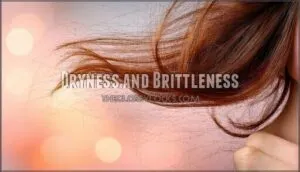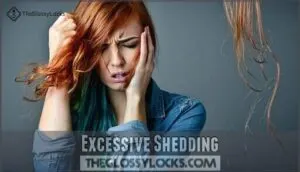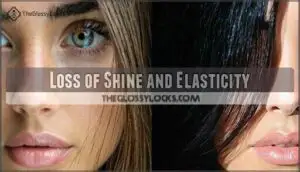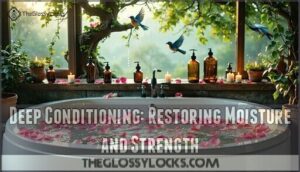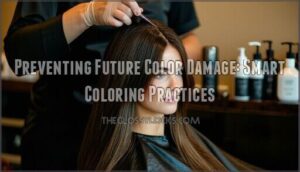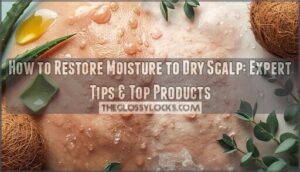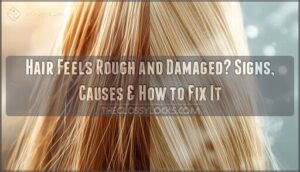This site is supported by our readers. We may earn a commission, at no cost to you, if you purchase through links.
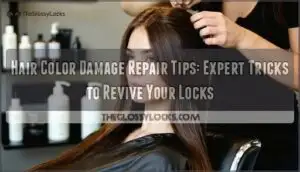
Swap out harsh shampoos for sulfate-free, pH-balanced options to keep your color from pulling a disappearing act.
Deep condition twice a week with protein-rich masks, and give leave-in conditioners a go for extra protection.
Ease up on heat styling—it’s not a race, so air-dry when you can.
Still seeing trouble? It might be time for a colorist’s expert touch.
These hair color damage repair tips can revive your locks and put you back in the driver’s seat.
There’s more—your next secret weapon might surprise you, and help with hair color damage repair.
Table Of Contents
- Key Takeaways
- Recognizing Hair Color Damage: Signs and Symptoms
- Immediate Actions for Color-Damaged Hair
- Professional Help: When to See a Colorist
- Gentle Cleansing: Choosing The Right Shampoo
- Deep Conditioning: Restoring Moisture and Strength
- Heat Styling Alternatives for Damaged Hair
- Nutrition for Hair Health: Diet and Supplements
- Natural Remedies to Support Hair Repair
- Long-Term Care: Maintaining Color-Treated Hair
- Preventing Future Color Damage: Smart Coloring Practices
- Frequently Asked Questions (FAQs)
- How can I repair my hair after chemical damage?
- How to reverse dye damage?
- How can I restore my damaged hair?
- Can hair dye damage split ends?
- How should you care for colored hair?
- What should I do if my hair color fades?
- How to repair damaged hair after coloring?
- How to stop breakage on dyed hair?
- How do you fix your hair after dying it too much?
- How to reduce frizz after hair color repair?
- Conclusion
Key Takeaways
- Switch to sulfate-free shampoos that are pH-balanced to protect your color and keep your hair from drying out.
- Deep condition with protein-rich masks twice a week, and don’t skip leave-in conditioners for extra damage control.
- Cut back on heat styling—let your hair air-dry when you can and try heatless styling tricks to prevent further breakage.
- Watch for warning signs like brittleness, shedding, and dullness; if things get worse, it’s time to see a colorist for expert help.
Recognizing Hair Color Damage: Signs and Symptoms
Before you can fix color-damaged hair, you need to recognize the warning signs your strands are sending.
Think of your hair as a messenger – when it starts breaking easily, losing its shine, or shedding more than usual, it’s basically waving a white flag asking for help.
Dryness and Brittleness
Most color-treated hair faces the dreaded dryness dilemma when chemical processes strip away natural protective oils, leaving your strands feeling like sandpaper. Hair color damage manifests through telltale signs that scream for immediate hair moisture intervention.
You’ll recognize dryness and brittleness through these unmistakable symptoms:
- Brittle strands that snap easily when stretched or brushed
- Dry ends that feel rough and look frayed, refusing to lay flat
- Loss of natural elasticity, making hair vulnerable to breakage.
Your hair’s cuticle layer becomes compromised during coloring, creating gaps that allow moisture to escape. This leads to increased porosity and that straw-like texture you’re battling. Frizz control becomes nearly impossible when your hair lacks proper hydration. Think of damaged hair like a sponge with holes – it can’t retain the hair moisturizing treatments you apply, making breakage repair your top priority for restoration.
Excessive Shedding
When you notice your brush collecting more strands than usual after coloring, you’re witnessing chemical-induced hair shedding in action.
Those harsh dyes containing peroxide and ammonia don’t just change your color – they weaken fragile strands right at the root, disrupting your scalp health and triggering what experts call telogen effluvium.
This excessive shedding typically appears within days of treatment, leaving you wondering if you’ll have any hair left.
The shedding causes stem from damaged hair follicles struggling to hold onto weakened strands.
While hair loss feels alarming, understanding that this hair breakage results from chemical stress helps you take control.
With proper hair damage repair techniques and gentler products, you can minimize future split ends and restore your hair’s natural strength cycle.
Loss of Shine and Elasticity
Spot the telltale signs when hair color damage strikes your strands like a thief in the night.
Loss of shine transforms vibrant locks into lackluster hair, while compromised hair elasticity means strands snap instead of stretch.
This damage disrupts moisture balance and increases hair porosity, leaving you desperately seeking color revival.
Here’s your shine restoration game plan:
- Weekly protein treatments rebuild damaged cuticles
- Deep conditioning masks restore moisture balance
- Cool water rinses seal cuticles for maximum shine
- Leave-in treatments with keratin boost hair elasticity
Split Ends and Breakage
Brittle strands that snap like twigs when you handle them? You’re looking at classic split ends and breakage from color damage. Your hair’s telling you it needs serious hair damage repair attention.
Split End Treatment starts with recognizing the enemy. Those frayed ends aren’t just cosmetic – they’re highway signs pointing to bigger problems ahead.
Quick Fix
Deep condition weekly
Breakage Repair means stopping the cycle before it spreads. Hair Trims every 6-8 weeks prevent splits from traveling upward. Damage Prevention beats expensive fixes every time.
Your hair breakage fix toolkit should include gentle detangling brushes and Frizz Control products that seal damaged cuticles. Remember – healthy hair color restoration starts with strong foundations.
Uneven or Fading Color
Your vibrant color starts betraying you when heat styling and chemical processing damage the hair cuticle, creating uneven porosity that releases pigments inconsistently.
Fading prevention becomes nearly impossible once your hair can’t hold onto color molecules properly.
This uneven color appears as patchy, multi-toned sections where some areas look washed-out while others remain saturated.
Professional color correction and tone restoration can address these pigment repair issues, but catching hair color damage early makes color enhancement treatments far more effective.
Immediate Actions for Color-Damaged Hair
When your hair’s screaming for help after color damage, act fast with these Emergency Fixes.
Your Hair Rescue mission starts immediately – think of it as damage control for your crowning glory.
First, ditch harsh shampoos for sulfate-free alternatives that won’t strip what’s left of your hair’s natural oils.
Your strands need gentle Color Repair, not more punishment.
Deep condition twice weekly with protein-rich masks – your hair’s basically begging for moisture right now.
Put those hot tools in timeout!
Heat styling damaged hair is like pouring salt on an open wound.
Try air-drying or heatless styling methods instead.
A quality leave-in conditioner becomes your new sidekick, creating a protective barrier while you work on hair color damage repair.
These Quick Fixes for hair repair won’t happen overnight, but consistency wins the race.
Your hair color protection strategy begins with babying those fragile strands back to health.
Professional Help: When to See a Colorist
Sometimes even the best DIY efforts can’t fix severe color damage, and that’s when a professional colorist becomes your hair’s best friend.
You’ll know it’s time to book that appointment when your strands feel like straw, your color looks patchy, or you’ve reached that "what have I done" moment we’ve all been there.
Assessing Damage Severity
Three key damage tests reveal your hair’s true condition.
Start with an elasticity check: gently stretch a wet strand—healthy hair bounces back, while damaged hair snaps.
Next, perform a hair porosity test by dropping water on clean strands; if it absorbs in under ten seconds, you’re dealing with severe hair color damage.
Finally, examine breakage analysis and follicle health by checking for excessive shedding and brittle texture that signals compromised color treated hair needing professional hair damage repair.
Understanding color retention factors is essential for effective hair care and maintenance.
Color Correction Techniques
Why settle for damaged color when professionals can work miracles? Color correction transforms your color treated hair through strategic techniques.
Professional colorists use advanced methods for complete vibrancy restoration:
- Color fixing removes unwanted pigments and brassiness
- Shade matching creates custom formulas for perfect results
- Toning options neutralize off-colors and enhance dimension
Balayage repair and specialized hair color repair processes restore your locks’ former glory, though expect $300-$600 per session for quality hair color maintenance.
Customized Treatment Plans
Beyond color correction comes damage assessment and personalized care.
Your colorist performs thorough hair analysis to understand your strand’s specific needs.
They’ll create customized treatment plans featuring targeted repair strategies like bond-rebuilding masks or color safe shampoo regimens.
Think of it as getting a prescription for your hair’s recovery.
These treatment options guarantee your hair color damage repair journey addresses root causes, not just surface symptoms.
Gentle Cleansing: Choosing The Right Shampoo
You’ll need a gentle, sulfate-free shampoo to stop stripping away both your color and hair’s natural oils—think of it as swapping harsh dish soap for a moisturizing body wash.
Look for pH-balanced formulas with color-safe ingredients like milk proteins that actually lock in your shade instead of washing it down the drain, which helps to preserve your color.
Sulfate-Free Options
When facing color-damaged hair, sulfate-free products become your lifeline.
These gentle cleansing formulas protect your investment while maintaining moisture lock and color preservation.
Why your hair will thank you:
- No more color bleeding – sulfatefree shampoo keeps vibrancy intact longer
- Soft, manageable texture – gentle products won’t strip natural oils
- Less scalp irritation – colorsafe ingredients reduce sensitivity
Professional colorists recommend these sulfatefree products because they understand pH balance matters for lasting results.
Using sulfate free shampoo can help preserve hair color and reduce damage.
PH-Balanced Formulas
Your hair’s natural pH balance is everything – it’s what keeps those cuticles sealed tight and your color locked in. pH-balanced formulas work like gentle bodyguards, protecting your strands from damage while keeping moisture exactly where it belongs.
These smart cleansers maintain your hair’s ideal acidity level, creating the perfect environment for healthy, vibrant locks.
- Sealed cuticles prevent color from washing down the drain
- Reduced frizz and smoother texture after every wash
- Enhanced moisture retention for softer, more manageable hair
- Gentler scalp treatment that won’t cause irritation or dryness
- Longer-lasting clean feeling without over-stripping natural oils
Using a pH balanced shampoo is essential for maintaining healthy hair.
Color-Safe Ingredients
Look for powerhouse ingredients like milk proteins, coconut oil, and aloe vera in your sulfate-free shampoos.
These moisture lockers and protein boosters work overtime to preserve your color while keeping strands hydrated. Gentle formulas with these color preservatives beat harsh sulfate alternatives every time.
Your hair color repair journey starts with smart shopping – these ingredients support hair color preservation without stripping your beautiful hues.
Using a sulfate free shampoo is essential for maintaining healthy and colorful hair.
Deep Conditioning: Restoring Moisture and Strength
Color-damaged hair feels like straw because it’s lost its protective moisture barrier, making deep conditioning your non-negotiable weekly ritual.
Think of it as emergency hydration therapy – your strands are literally thirsty for the rich proteins and oils that’ll rebuild what chemical processing stripped away, providing deep conditioning.
Weekly Hair Masks
Imagine a tall glass of water for parched hair—that’s what weekly hair masks deliver.
Making deep conditioning a habit gives your locks a serious moisture boost and loads of other Hair Mask Benefits.
Once a week, smooth on a thick hair treatment mask right after using moisturizing shampoos, and let the formula soak in for maximum Hair Repair.
Consistency is key for Mask Frequency: stick with it, and you’ll notice stronger, shinier hair that bounces instead of breaking.
Using the right hair mask products can substantially enhance the effectiveness of your hair care routine.
Leave-in Conditioners
Spritz on some leave-in conditioner and let your locks drink up the moisture. Leave-in products are like bodyguards for your hair, standing watch against future color damage and daily wear.
You’ll notice knot-free detangling, smoother styling, and a soft, healthy sheen––all while locking in hydration. Conditioner tips: don’t overdo it, and focus on mid-lengths and ends.
Good leave-in conditioner is your no-fuss, Moisture Lock go-to for fast Damage Repair.
- Less breakage
- Smoother finish
- Easier styling
- Ongoing hydration
- Enhanced color longevity
Protein Treatments
You’ve handled leave-in conditioners—now step up your game with protein treatments. Think of Protein Masks or a quick Keratin Treat as armor for your strands.
These formulas patch weak spots and seal the cuticle, which means less breakage, better shine, and major Hair Repair points. But in the quest for Hair Strengthening, don’t overdo it—protein overload can backfire.
For smooth Damage Fix, plan a protein treatment every few weeks, and always pair it with moisture-rich care to keep your hair balanced. Understanding hair protein treatments is key to restoring damaged hair.
| Protein Type | Main Benefit |
|---|---|
| Keratin | Cuticle repair |
| Hydrolyzed Wheat | Adds volume |
| Collagen | Improves strength |
| Soy Protein | Boosts shine |
| Amino Acids | Moisture retention |
Heat Styling Alternatives for Damaged Hair
If your hair feels as tired as a flat iron on overtime, it’s time to give it a break from the heat.
You’ll learn easy, effective ways to style your hair without hot tools, so your locks can finally get a vacation too.
Air-Drying Techniques
Shake off the heat—Air Drying isn’t just effortless, it’s smart for damaged hair. Start with a Microfiber Towel for gentle blotting; cotton can cause frizz. Next, work in that leavein conditioner for max moisture and slip. Add a drop or two of lightweight oil for hydration that sticks.
Let your strands airdry while you sip coffee or answer emails. For extra curl enhancement, try a quick scrunch and skip the diffuser attachment—your hair will thank you with healthy shine and bounce.
Understanding proper hair drying techniques is vital for minimizing damage and preserving color.
- Air Drying preserves color and reduces breakage
- Microfiber Towels help absorb water without damage
- Leavein conditioner keeps your hair moisturized all day
- Curl Enhancement is easy with a simple scrunch
Heatless Curling Methods
There are countless ways to curl your hair without ever plugging in a hot tool—welcome to the sphere of heatless styling! These hair curling tricks save your strands from color damage while serving up bounce and volume.
Try Sock Curls for waves that look like you woke up like this, or Headband Curls for effortless ringlets overnight. Roll with Rag Rolling, give Braid Curls a go, or twist things up with easy Twist Outs.
Pin Curls and bendy rods offer another layer of curl forming fun. With these heatless hairstyles, you’re not just skipping the heat—you’re making hair styling alternatives part of your nightly ritual.
Protective Styling Options
If your hair’s in recovery mode, it’s time to give protective styling a try.
Opt for low manipulation options—gentle twists or classic braided styles—so you skip the stress of daily heatless styling.
Hair tucking with a silk wrap protects your ends and feels luxurious, and helps prevent breakage.
Switch up your hair care routine with satin or silk pillowcases: it’s like smooth roads after years of potholes.
These simple moves can seriously boost hair damage prevention, letting your next hair mask work overtime.
Nutrition for Hair Health: Diet and Supplements
Your hair craves nutrients just like the rest of your body, so filling your plate with protein, vitamins, and healthy fats can make a real difference in strength and shine.
You don’t have to eat a salad at every meal, but a balanced diet and the right supplements can help your hair bounce back—no magic required.
Essential Vitamins and Minerals
After trying heatless styling tricks, don’t forget what’s happening underneath the surface.
Your strands need the right nutrition every day to truly bounce back. Think of it like feeding your garden with more than just water.
- Biotin Role: Fuels growth, keeping your hair thick and resilient.
- Vitamin E: Shields against oxidative damage—like a bodyguard for your strands.
- Iron Supplements: Help prevent shedding and keep roots strong.
- Zinc Benefits: Essential for scalp health and new growth.
- Vitamin B & Omega Rich foods: Boost shine and recovery.
Smart nutrition is the ultimate hair health tip!
Protein-Rich Foods
You’ve loaded up on essential vitamins—let’s make your next plate a protein powerhouse.
Reach for Greek yogurt, Fish Oil, egg whites, or even lean meats to fuel follicles and boost hair repair.
Lentils, nuts, and seeds make easy add-ins.
These protein-rich foods support a healthy hair care routine and keep those trims farther apart.
Hydration Importance
Keeping your hair well-hydrated isn’t just a beauty tip—it’s your ticket to real moisture balance and elasticity recovery.
Good hydration starts on the inside with steady water intake and continues outside with the right hair moisturizing tips and products. Think of your scalp and strands as a moisture bank—healthy deposits keep it thriving.
Incorporating biotin rich foods can also help prevent hair loss and promote hair growth.
- Drink two liters of water daily for ideal hair hydration
- Use coconut oil to boost moisture and support hair porosity
- Pick hydrating masks and moisturizing dye options
- Add fruits and veggies to fuel moisture from within
- Gently massage your scalp and avoid harsh shampoos
Natural Remedies to Support Hair Repair
You don’t need a chemistry degree or fancy bottles to give your hair a helping hand—kitchen staples like coconut oil and aloe can do the trick.
With everyday ingredients and a bit of patience, you can strengthen and restore your locks, even if they’re feeling more haystack than hair day.
Oil Treatments
Looking for an easy fix after tuning up your nutrition?
Oil treatments step up next. Natural oils—think coconut, olive, or almond—work wonders for scalp health and hair repair.
Massage in a little, cover with a warm towel, and relax. For best results, try weekly sessions.
It’s a pro-approved, budget-friendly method for hair damage repair and long-lasting hydration!
DIY Hair Masks
Ever wonder how to beat dull, color-damaged hair at home?
Whip up DIY hair masks using simple DIY ingredients like avocado, banana, or coconut oil. Apply homemade recipes from root to tip and leave on for 20 minutes.
Stick to a weekly mask frequency for targeted repair. It’s natural hair repair that saves cash—easy, mess-free, and totally doable!
Herbal Rinses
For a simple herbal rinse, steep rosemary or chamomile to boost shine and perk up tired strands—basically, it’s hair rehab in a mug.
These DIY recipes help soothe your scalp and restore some bounce, especially after color damage.
For best results, pour the cooled rinse over clean hair weekly. It’s an easy way to support scalp health and repair.
Scalp massages can also stimulate hair growth and improve overall hair health.
Long-Term Care: Maintaining Color-Treated Hair
Keeping your color-treated hair healthy takes more than just luck—consistent care is your best bet.
With a few simple habits like regular trims, UV protection, and a silk pillowcase, you’ll help your vibrant color last long after your last salon visit, which is key to maintaining healthy hair.
Regular Trims
A stitch in time saves nine—and regular trims are your behind-the-scenes hero in damaged hair care.
Snipping split ends every 6–8 weeks isn’t about losing length; it’s about Split End Removal, Growth Encouragement, and keeping your style on point.
Trim Frequency helps with Texture Improvement and Shape Maintenance, making these trims top-tier hair repair tips for anyone serious about hair damage control.
UV Protection
After keeping split ends in check, don’t shrug off UV damage.
Sun exposure can zap vibrancy, speed up color fading, and even cause scalp sunburn.
Reach for UV-protective products—think leave-ins or sprays built for hair care—and pick out that wide-brimmed sun hat.
Layering up delivers the kind of hair repair and control your color-treated locks crave for long-lasting shine.
Nighttime Hair Care
A silk pillowcase could be your secret weapon in the battle against hair damage—think of it as a velvet rope keeping friction at bay.
Swap out cotton for silk or toss on a satin bonnet, and you’ll wake up with smoother strands and fewer tangles.
Try braiding your hair or using protective hairstyles at night to reduce breakage.
Massage some hydrating serums or a lightweight overnight mask into your scalp before bed for a mini spa treatment.
Consistent nighttime hair care isn’t just beauty sleep; it’s hair strengthening treatment and repair, rolled into one.
Preventing Future Color Damage: Smart Coloring Practices
If you want to keep your color fresh and your hair strong, choosing smarter coloring methods makes all the difference.
Space out your color sessions and try gentler dyes—your hair will thank you, and you won’t have to hide under a hat after every appointment.
Spacing Out Color Sessions
After all, long-term hair care is about working smarter, not harder.
Spacing out your color sessions is your secret weapon against hair color damage—your strands need room to recover.
By waiting between visits, you’ll notice:
- Less breakage and dryness.
- Natural root smudging for that lived-in look.
- Enhanced Balayage Benefits and Color/Gray Blending for true Low-Maintenance Color.
Your future self (and your hairstylist) will thank you for adopting this smart approach to hair care.
Choosing Gentler Dyes
After waiting between color sessions, it’s smart to reach for gentler dyes.
Ammonia-free and organic options treat your hair like a velvet glove—no more harsh fumes or burning.
Natural dyes, such as henna or plant-based formulas, offer rich color deposits that don’t wreck your strands.
Thinking about experimenting? Try a demi-permanent or semipermanent hair dye.
These gentle formulas let you play with new shades while dodging the usual pitfalls of hair color damage and tricky color correction.
Pre-Color Hair Preparation
Even before you book a color appointment, smart precolor preparation is your secret weapon.
Start by deep conditioning to boost moisture levels and elasticity. Do a quick porosity test to check how your hair absorbs water.
Use a clarifying shampoo after, clearing out buildup helps color grab evenly and keeps damage evaluation accurate.
Try these steps:
- Hair Assessment
- Porosity Test
- Deep Conditioning
- Clarifying Shampoo
Frequently Asked Questions (FAQs)
How can I repair my hair after chemical damage?
First, cut split ends and use a sulfate-free shampoo.
Weekly deep conditioning and leave-in treatments help.
Add a dash of patience, avoid more chemicals, and limit heat styling.
Repairing hair isn’t fast, but it’s totally possible!
How to reverse dye damage?
Ever notice that your hair feels like straw after a bad dye job?
Dial back the damage by using sulfate-free shampoos, protein masks, leave-in conditioners, and regular trims.
Skip hot tools—your hair will thank you later!
How can I restore my damaged hair?
Trim split ends, wash with sulfate-free shampoo, and deep-condition weekly.
Use leave-in conditioners, avoid hot tools, and sleep on silk pillowcases.
Stick with gentle brushes and good nutrition. Recovery takes time, but your patience will pay off.
Can hair dye damage split ends?
Hair dye doesn’t heal split ends—it’s like putting fancy paint on a cracked wall.
Color can actually make those frayed tips worse.
Snip off the damage first, or you’ll keep chasing rough, unruly ends.
How should you care for colored hair?
Use sulfate-free shampoo, condition deeply every week, and go easy on the hot tools.
Cool water is your friend—keeps color bright.
Don’t skip trims! Even a little TLC makes “salon-fresh” last longer.
What should I do if my hair color fades?
Like a faded pair of jeans, dull hair color calls for action—wash with color-safe shampoo, deep condition weekly, skip hot water, and limit sun exposure.
Think hats, shade, and touch-up toners for revived shine and vibrancy.
How to repair damaged hair after coloring?
Swap your harsh shampoo for a sulfate-free one, deep condition like it’s your superpower.
Skip hot tools, and baby your ends.
Even sleeping on a silk pillowcase gives fried locks a fighting chance at recovery.
How to stop breakage on dyed hair?
Worried about breakage?
Shampoo just two or three times a week, keep trims regular, and deep-condition with protein-packed masks.
Ditch tight ponytails and swap your towel for a soft T-shirt—your hair will thank you.
How do you fix your hair after dying it too much?
Deep condition every week, trim away split ends, and treat hair gently—like it’s spun from gold.
Cut back on heat styling, sleep on a silk pillowcase, and let nourishing masks work their magic over time.
How to reduce frizz after hair color repair?
Grab a leave-in conditioner with proteins or oils to calm the fuzz.
Sleep on silk pillowcases and cut the hot tools; your hair’s tired, not lazy.
A pea-sized dab of serum tames wild strands instantly.
Conclusion
Much like the mythic phoenix, your hair can rise from the ashes with the right hair color damage repair tips.
When you consistently pamper your hair with gentle cleansing, deep conditioning, and mindful styling, you’re setting yourself up for strong, vibrant color.
Don’t hesitate to adjust your routine or seek professional help—hair bounce-backs are real.
Remember, even small changes make a big impact, so keep making smart choices and let your healthiest hair take center stage.
- https://www.webmd.com/diet/rice-bran-oil-good-for-you
- https://stylesprinter.com/best-hair-masks-for-damaged-hair/
- https://www.healthline.com/health/protein-for-hair
- https://www.womansworld.com/beauty/hair/lived-in-blonde-hair-color-the-low-maintenance-coloring-technique-that-can-be-done-at-home
- https://www.kerastase-usa.com/collections/fusio-dose/fusio-dose-in-salon-hair-treatment.html

